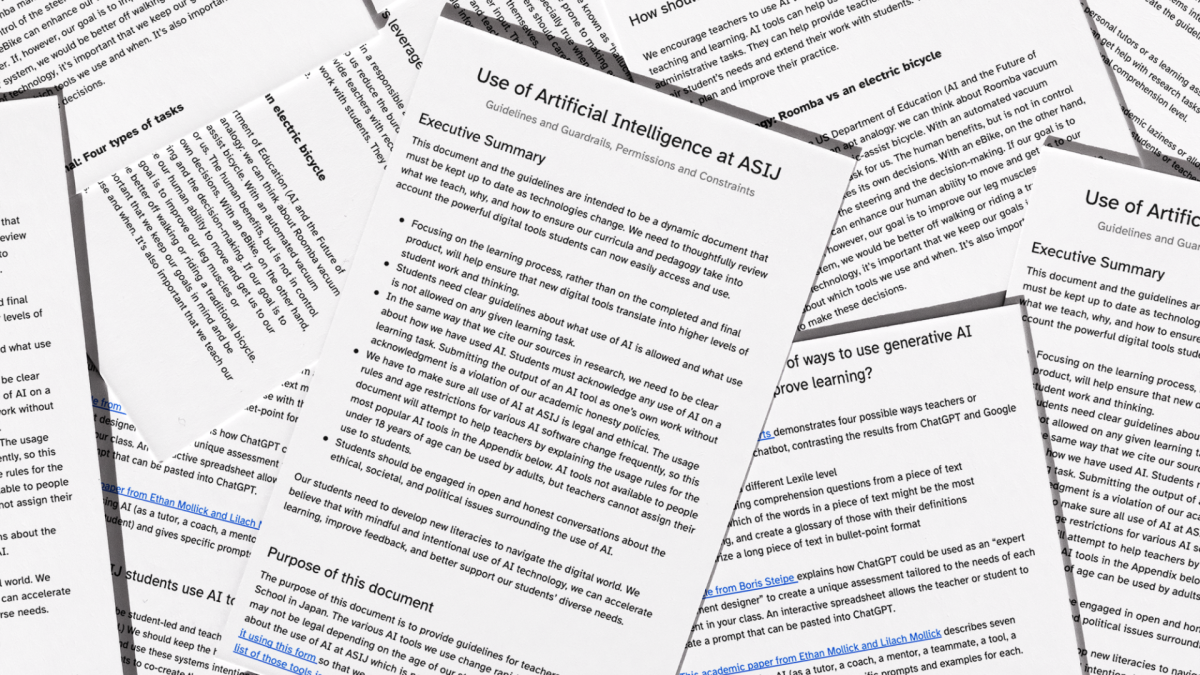On August 29, ASIJ unveiled a set of guidelines and guardrails for the use of artificial intelligence (AI) to students. These guidelines are designed to provide guidance for the integration of AI into education at ASIJ while emphasizing ethical use and academic integrity. This marks the first time the school has established a comprehensive school-wide document for AI use, covering all divisions from elementary to high school.
The rapid evolution of AI technology across the globe has generally outpaced policy. A “dynamic document,” the 27-page set of guidelines is designed to evolve continuously to adapt to emerging AI technologies and practices.
The document came after a months-long process of exploration and research by the school administration that started in January of 2023, which included looking into technology policies implemented by other schools and universities, holding meetings with students and faculty, and discussions with the Leadership Team.
Nadine Dickinson, ASIJ’s Curriculum Coordinator, moderated focus groups with MS and HS students, alongside discussions with faculty from all three divisions. During these discussions, two major themes emerged: the need to discourage academic laziness and the desire to promote more critical thinking. “As a school, we collectively agreed that our approach to AI should be constructive, not punitive,” she said.
Conversations about AI in educational settings also revealed various opportunities identified by the school community.
“For example, you can have a conversation with a character from history,” Ms. Dickinson said. She highlighted not only the potential for personalization and deeper interaction with learning materials but also emphasized that several groups she spoke with regarded language models like ChatGPT as valuable “sounding boards,” offering initial inspiration.
High school English teacher Anjali Nirmalan agrees. Viewing AI as a “skill builder,” rather than an inhibitor to authentic learning, she hopes to find opportunities to meaningfully integrate AI into her classroom this year.
“One of the things that I really liked was that both the students’ and the teachers’ views were very aligned — they identified the same concerns and also the same opportunities,” Director of Technology Warren Apel said.
In the weeks following the 2022-23 school year, Dr. Brad Augustine, along with the principals, the Head of School, and the Deputy Head of School, analyzed the data gathered from conversations with students and faculty. “We spent a couple of days of work, looking at all of that data, and then trying to put together a document that addressed all of our different concerns, advantages, our philosophy on it, as well as different AI tools that kids can use,” Dr. Augustine said.
In early August, Mr. Apel’s drafts were presented to the Leadership Team, the heads of high school departments, and the faculty at large in-between several rounds of editing and revision.
Throughout the drafting process, Mr. Apel looked closely at AI policies utilized by universities and examining bodies like the College Board and the International Baccalaureate. Additionally, he referred to a 71-page document published by the U.S. Department of Education, which provided insights and recommendations for AI use in educational settings. “I worked with the divisional leadership teams, the principals, and Dr. Hardin to look at that document and see if our guidelines aligned with what the Department of Education thinks are best practices,” Mr. Apel said.
These best practices include harnessing AI to enhance educational outcomes while safeguarding human decision-making and interrogating the quality of data used to train models to ensure that learning is authentic and meaningful.
In alignment with these values, the guideline document warns of “very believable untruths” generated by AI chatbots and emphasizes a“focus on [the] learning process,” rather than the final product. Failure to acknowledge the use of AI is also established as a breach of academic integrity, and firm emphasis is placed on the “legal, safe, and ethical use” of any software.
Teachers have already started incorporating AI in their classrooms. Last year, Ms. Anjali encouraged her freshman students to utilize ChatGPT to compose emails after noting that many felt “intimidated” about emailing their teachers. In Drama class, where students are evaluated primarily on their monologue delivery rather than the content, AI takes on the role of a scriptwriter.
 Even in the Early Learning Center (ELC), educators have embraced the potential of AI to personalize learning experiences. In one unit, teachers crafted short stories tailored to each student’s unique interests and backgrounds through ChatGPT, which were later used during read-aloud sessions.
Even in the Early Learning Center (ELC), educators have embraced the potential of AI to personalize learning experiences. In one unit, teachers crafted short stories tailored to each student’s unique interests and backgrounds through ChatGPT, which were later used during read-aloud sessions.
The guidelines document also encourages students and teachers to “co-create” rules, allowing them to tailor recommendations to specific classes or subjects. Roberto de Leon, an MS Humanities Teacher, intends to introduce a document titled “The ChatGPT Cheat Sheet” to his class in the upcoming weeks, setting AI-related boundaries specific to his classroom setting.
“There’s a lot of opportunity for personalization. I also think it aligns really well with the student-led, teacher-framed model,” Mr. Apel said.
Teachers’ approaches to leveraging technology in their classrooms will continue to evolve as AI reaches new levels of sophistication and advancement. At its core, the guideline document aims to offer guidance and establish clear boundaries in the midst of this rapidly evolving landscape.
“I imagine every single approach that we take to teaching and learning will have to be reevaluated over the next five, three years — or less than that,” Dr. Augustine notes. “The document predicts the need to approach the fundamental ideas of teaching and learning differently because of these tools. But what that looks like is not as clear right now.”


